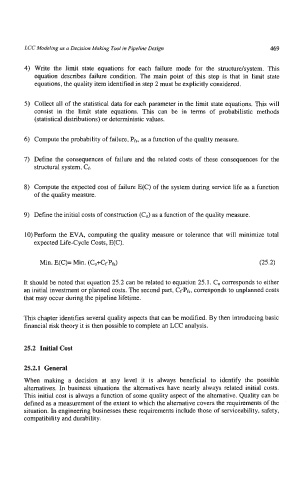Page 502 - Pipelines and Risers
P. 502
LCC Modeling as a Decision Making Tool in Pipeline Design 469
4) Write the limit state equations for each failure mode for the structure/system. This
equation describes failure condition. The main point of this step is that in limit state
equations, the quality item identified in step 2 must be explicitly considered.
5) Collect all of the statistical data for each parameter in the limit state equations. This will
consist in the limit state equations. This can be in terms of probabilistic methods
(statistical distributions) or deterministic values.
6) Compute the probability of failure, Pfs, as a function of the quality measure.
7) Define the consequences of failure and the related costs of these consequences for the
structural system, Cf.
8) Compute the expected cost of failure E(C) of the system during service life as a function
of the quality measure.
9) Define the initial costs of construction (C,) as a function of the quality measure.
1O)Perfom the EVA, computing the quality measure or tolerance that will minimize total
expected Life-Cycle Costs, E(C).
Min. E(C)= Min. (C,+CrPf,) (25.2)
It should be noted that equation 25.2 can be related to equation 25.1. C, corresponds to either
an initial investment or planned costs. The second part, CrPf,, corresponds to unplanned costs
that may occur during the pipeline lifetime.
This chapter identifies several quality aspects that can be modified. By then introducing basic
financial risk theory it is then possible to complete an LCC analysis.
25.2 Initial Cost
25.2.1 General
When making a decision at any level it is always beneficial to identify the possible
alternatives. In business situations the alternatives have nearly always related initial costs.
This initial cost is always a function of some quality aspect of the alternative. Quality can be
defined as a measurement of the extent to which the alternative covers the requirements of the
situation. In engineering businesses these requirements include those of serviceability, safety,
compatibility and durability.

